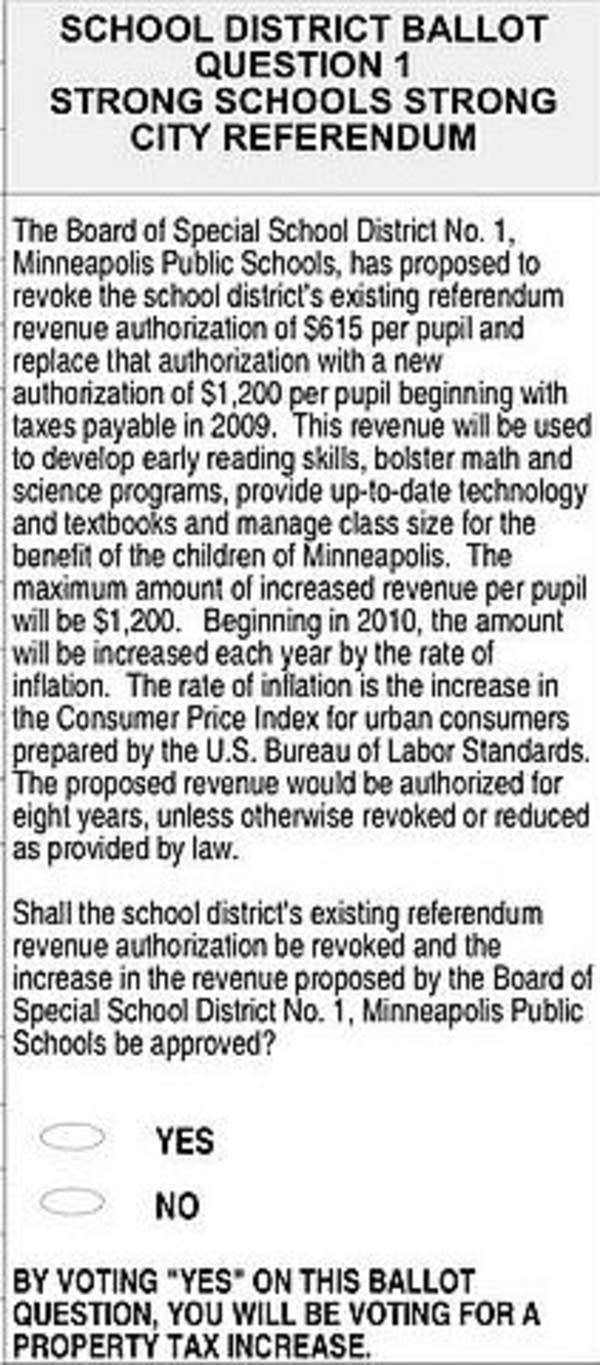Mpls schools could add funding and board members with votes
Go Deeper.
Create an account or log in to save stories.
Like this?
Thanks for liking this story! We have added it to a list of your favorite stories.

The first question would raise property taxes on a $250,000 house by about $200 a year.

Supporters, like Superintendent Bill Green, say the extra money is needed because the state hasn't kept pace with education funding, and the district will have to make deep budget cuts without the extra money.
"When we ran the previous referendum, it was based on an assumption that the state and federal government would continue the allocation formula they had set out," Green said. "That we would be able to anticipate that they would keep pace with the cost of living and other factors.
"They didn't, and so we feel we can't make the same assumptions (now)."
Turn Up Your Support
MPR News helps you turn down the noise and build shared understanding. Turn up your support for this public resource and keep trusted journalism accessible to all.
There is no formal campaign opposing the levy, but voters have expressed opposition.

"I finally reached a point where the combination of the higher taxes and low performance [of schools] has persuaded me that perhaps it's time to reconsider whehter just throwing more money at the problem will help," says Bob Seidel, in an interview.
Seidel is a professor at the University of Minnesota who says he's never before voted against a school levy, but will next week. He was responding to a query made by MPR's Public Insight Network on the levy.
(To view more responses from voters, click here)
SECOND BALLOT QUESTION

The second question will ask voters to change the make-up of the city's school board. There are currently seven members of the board - all of them are elected citywide. If next week's proposal is approved, the board would expand to nine members - three would be elected at-large, six would be elected by district.
The proposal stipulates the new school board districts would mirror district boundaries for the Minneapolis Park & Recreation Board.
The history of this ballot proposal dates back to 2006, when Rep. Jim Davnie, DFL-Minneapolis, sponsored and won passage of legislation that gave the district two options: Have the school board vote to change its makeup, or put the question to voters.
The School Board voted against the proposal, which spawned next week's ballot question.
Supporters of the ABC referendum, as it's called, point to a need for a board that better represents the city and makes sure that all parts of the city are represented.

"We need government structures that work for now," says Davnie, a former teacher. "There's a greater desire on people's part to make sure elected bodies reflect the diversity of the city; different areas of the city have different perspective on things; and that the school board - as other elected bodies - are accountable back to the community."
Davnie says it's one thing to visit a school; it's another thing to truly know a community. He says some parts of Minneapolis have never had representation on the board and, as a result, those areas of the city are seeing the sharpest declines in enrollment because there's no connection to the district.
Another argument points out that the school board is the only government body in Minneapolis that doesn't elect from districts - the city council is split into wards, while state lawmakers and county board members represent districts.
But opponents to the measure use that argument.

"I think that's precisely the issue - a school board is not like city council or a state legislator," said Pam Costain, a current Minneapolis School Board member. "A legislator is actually elected to represent a specific part of the state. I believe strongly that school boards are elected to govern the system as a whole. Their governance charge is to govern an entire district.
"It's a real fundamental difference," she says.
As for the diversity supporters say the district would realize from having districts, Costain notes the current board is more diverse than any other elected body in the area. Currently, five of the seven school board members are people of Color.
Opponents also worry that a district school board member would rightly look out for his or her own district and oppose, for example, a plan to close a school in that district - even if that board member felt it was the right move for the entire district.
It's hard enough to recruit good, qualified candidates to run for school board, Costain says. It's a job that only pays $13,000 a year and eats up all of your free time, she says. If the board grew by two, it would be that much harder to recruit qualified candidates.
Currently, 11 school districts in Minnesota elect their boards by district, including Anoka-Hennepin - the largest district in the state, in terms of enrollment.




